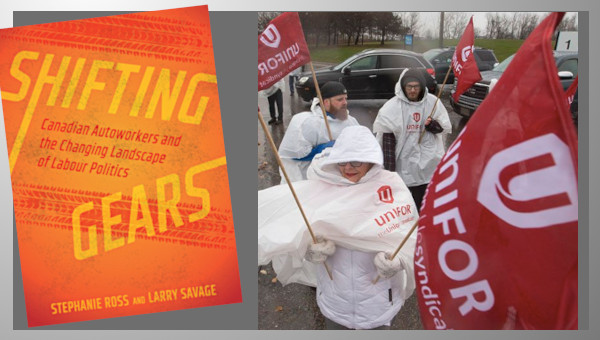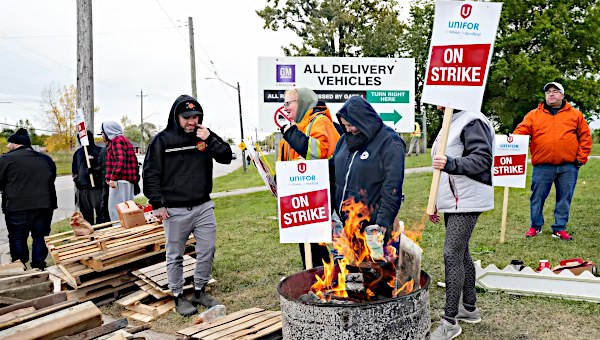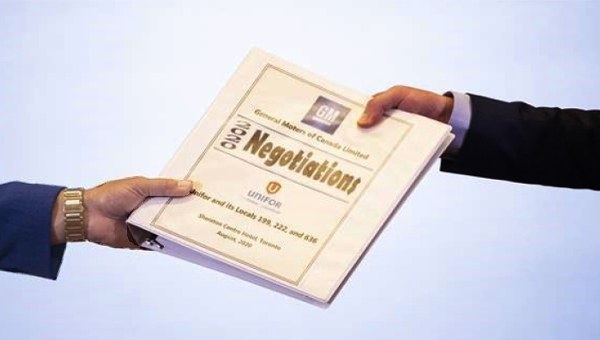Two-tier Wages, Second-Class Workers
When Autoworker President Buzz Hargrove makes new pronouncements, they carry weight within and beyond the labour movement – even when, as has recently been the case, they seem to undermine what Canadian unions have always stood for. What then are we to make of Hargrove’s defiant declaration, in response to the permanent two-tier system negotiated in the U.S., that this is one automotive import that won’t cross the border into Canada?
The significance of the “two-tier system” is that it takes the inequalities that have been growing within the workforce to a new stage: it brings them right into the workplace and includes the union as an accomplice. The agreement last fall between the UAW and GM, Ford, and Chrysler divided jobs into “core” and “non-core” jobs. The wage rate for workers newly hired into the non-core jobs will be permanently cut in half and benefits still further – in spite of these workers doing the exact same work as others getting the higher rate. This agreement was sold on the basis of needing to compete with the Japanese transplants and doing do in a way that would shift the concessions to future workers. For the young workers to come, this has not only reduced their access to decent-paying jobs, but done so in a way that formally defines them as permanent second-class workers – hardly a formula for generating the enthusiasm, amongst a new generation of workers, that is so critical for any revival of unions.
But is it possible, in this most-integrated of industries and with the rise of the loonie, for Canadians to ignore the developments in the USA? The high value of the loonie is indeed a serious problem for the Canadian auto industry (and Canadian manufacturing more generally). But the Canadian operations still benefit from Canada’s health care system; even with the companies shifting the risk of health care on to their employees, the company share of costs for active workers and of the new funding arrangements remain high relative to Canada. Factoring in the high productivity and quality of Canadian plants, the likelihood of a long-run Canadian dollar in the $.93-.95 range, and the fact that labour costs are in any case under 10% of the price of a vehicle, mean that the rise of the loonie is in fact not that decisive. Jobs, as the past three decades could not have made any clearer, depend on both larger corporate strategies and circumstances beyond the companies control: between 1978, when the era of concessions began in the U.S. and the present, UAW Big Three membership has fallen by some 80% – from 750,000 to under 170,000.
Yet, if U.S. auto wages do start moving to half their present level, Canadian autoworkers could clearly not simply “bargain as usual.” The key here lies in how American workers themselves respond. Many American workers did vote against this agreement (almost half at Chrysler and one-third at GM) and more are coming on side as they come to see that even in terms of competitiveness, the two-tier system is a sham. Japanese auto companies have a well-developed two-tier system at home, but have not implemented it in their U.S. plants for fear of this driving their workers to unionization. With the UAW now bringing it into American plants, the door will be opened for the Japanese companies to now follow suit. Net result: lower wages for autoworkers at the big Three and the transplants paying for higher salaries to corporate executives and greater dividends to stockholders, with absolutely no change in relative competitiveness and job security.
This dawning recognition has led to an impressive opposition emerging in the U.S. that is determined to cast out this offensive system in its own bargaining in 2011. In this context, what happens this coming fall in Canada is crucial. A Canadian surrender would weaken that movement, but if the Canadians do challenge it this has the potential to inspire and deepen the resistance in the U.S. thereby ease longer-term pressure on the Canadians.
There are those in the labour movement (and perhaps some within the CAW) who treat Hargrove’s promise to take on such a fight with great skepticism. They raise the concessions earlier made in Oshawa, Bramalea and elsewhere, and note that Hargrove was hardly worried about the inequalities facing workers when he came out in support of politicians who bore a large responsibility for the policies that aggravated those inequalities. They point to the Magna agreement which, in surrendering the right to strike and the right of workers to democratically determine their own in-plant structures, essentially created a two-tier system within the CAW. And some question whether, if the CAW does reject the two-tier system, it will only do so by letting the companies achieve the same results in other forms (e.g. though outsourcing) or at the expense of concessions elsewhere (giving up time off the job).
Yet, Hargrove’s strong statements against the American agreement are surely welcome. Hargrove has stuck his neck out and if the CAW in fact takes on this fight it, the rest of the labour movement must be there in support – for reasons of solidarity, self-interest and the future of its own shaky status. •





